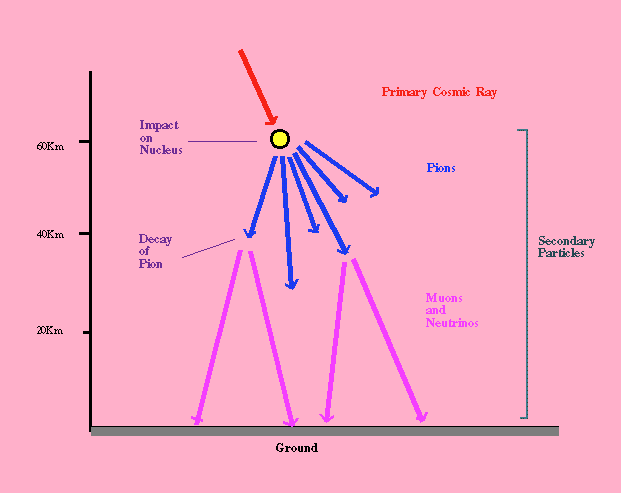
|
The
Spark Chamber
|

|
Last updated Summer 2010
Stephen Bull, James
Fleming and Jessica Cuttriss
A
Spark
Chamber is a device used for detecting charged particles, it was
widely
developed and used in the 1970s. Now, even though more up-to-date
equipment has been developed, it is still used for educational
purposes,
due to its relative simplicity and its usefulness in researching
subatomic particles. This
web page is dedicated to providing information about Spark Chambers to
those who have a basic understanding of particle physics, but wish to
learn more. Also, those who have a flair for physics may find the
information useful in developing their understanding of cosmic
rays and charged particles.
Below is a
table of contents
to help you navigate your way around the site.
Why do people study Physics?
"What is the world made of?" "What holds it together?" are
the two
questions which particle physicists
ask themselves everyday - before they go about setting up experiments
in
order to test their theories, and eventually answer the questions.
The
world is made up of fundamental
building blocks; fundamental is used in
the sense that these so-called building blocks are simple and
structureless, and cannot be made up of anything smaller (elementary particles).
Atoms consist of a nucleus which is surrounded by a cloud of
electrons.
Elements are
arranged within the periodic table (left to right and top to bottom) in
order of increasing atomic number. Atomic nuclei have a charge +Ze, where e is the magnitude of the charge on
an electron and Z is the atomic number.
Z determines the number of atomic electrons and hence the ordered
position of that species of atom in the periodic table. This order
generally coincides with
increasing atomic mass. The periodicity of the periodic table is
explained beautifully by the conservation rules of quantum mechanics.
As it is possible to build a periodic table this suggests that atoms must be made of simpler building blocks and
therefore are not elementary
particles.
| Protons
and Neutrons |
Quarks |
|
The nucleus is made up of protons
and neutrons. The proton is a positively
charged particle having a mass of 1.673x10-27kg
whereas the
neutron has no electric charge
and has
slightly greater mass of 1.675x10-27kg.
Both
proton and neutron
have a radius of 10-15m and are held together by the strong nuclear force. Nuclear
physics
is
another
branch of physics in which the physics of the atomic nucleus is
studied. Nuclear physicists are concerned with understanding the
properties of nuclei in terms of the behavior of their constituents. |
Protons and neutrons are not elementary particles, as they
consist of sets of point-like
particles called quarks
held together by the exchange of particles
called gluons.
Current understanding is that quarks
and gluons have no sub-structure. Quarks do not exist on their own, so cannot
be separated from the proton or neutron in which they are contained. Electrons are a different type of
fundamental particle which do not interact with gluons.
|
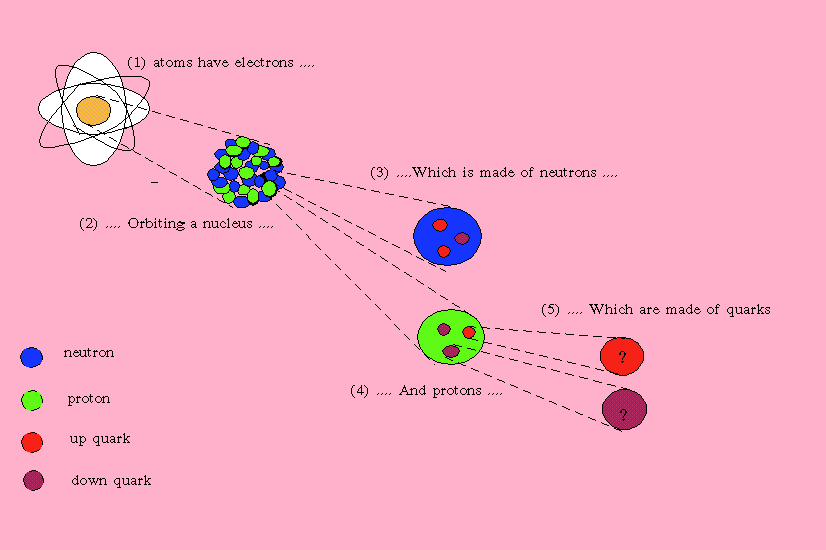
What is a spark
chamber? What does it have to do with physics?
A spark chamber is a device which is used for detecting charged particles. It is
one of many detector devices used by
elementary particle physicists in the search for a greater
understanding of the subatomic
particles which make up the universe.
In current research, the spark chamber has become largely redundant, as
it has been
replaced by faster and much more sophisticated detectors with better
time and spatial resolution. For
example, the OPAL experiment at
the Large
Electron-Positron (LEP)
accelerator at CERN (homepage)
used drift chambers, while ATLAS (homepage) makes extensive use of silicon
detectors. These detectors measure
the trajectories of
different charged particles.
However, the spark chamber is still of great scientific value, in that
it remains relatively simple and cheap to build (compared to the LHC at
CERN,
which took 20 years and as well as $9 billion dollars) and it enables
an observer to view the paths of charged particles.
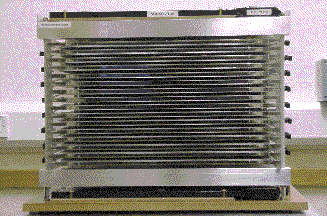
A picture of the
portable spark chamber made at The University Of
Birmingham.
A time line to show
the development and usage of the spark chamber throughout history.
| 1949 |
Keuffel
First
observed that discharge
between parallel plates occurred along
the path of a cosmic ray. |
| 1953 |
Bella and Frazinetti, took
photos of spark discharges and published them. |
| 1955 |
(1) Used several
parallel plate
counters ( called "modules") |
|
(2) Enhanced
the spark with a
triggered condenser discharge
(e.g. Argon or Alcohol) |
|
(3) Took stereo
photographs. |
| 1957 |
Harwell,
Cranshaw and Da Beer looked into applying high
voltage to the plates immediately after
the charged particle had
passed through the spark
chamber. They also developed
the triggering of the chamber. |
| 1959 |
Fukui and
Migamoto |
| 1963 |
Alikhanian
came up with the idea of
leaving enough space between the
plates
so a spark could be observed. |
| >1970 |
The
spark
chamber became the primary device used to
demonstrate and research sub atomic particles, before being replaced by
bubble chambers, drift chambers, ... |
Detectors
and the Particle Physicist
Detectors are devices used by elementary particle physicists in
the
search for a greater understanding of
the subatomic particles which
make up the universe. As well as detecting charged particles, detectors
can be used to detect radiation, making them a useful tool in other
aspects of science such as in nuclear physics experiments, nuclear
medicine and geological exploration. This section gives a brief
insight into the detectors which replaced the spark chamber.
A wide range of detector devices exist, such as the cloud, bubble
and
proportional chambers. All of the
detectors along the same fundamental principle: the transfer
of some or all of the
energy of a particle to the detector mass, where it is converted
into a a more readily observable form such as visible light.
The form in which the converted energy appears depends on the
detector
and its design. Gaseous detectors such as drift and multi wire
proportional chambers (MWPC) output a current signal, whilst
scintillation counters produces a light pulse. Modern detectors are
electrical in nature and output pulses which
are analysed by electronic means.
Before the development of the proportional and drift chambers
during
the late 1960's, the spark chamber was widely used as a triggerable
track detector. The spark chamber itself was a development of the spark
counter.
The spark counter consisted of a pair
of parallel plates with a
high
potential difference between them, in a gaseous atmosphere, used in the
same way as a Geiger-Muller tube. The main difference between the spark
counter and the spark chamber was the use of photographic rather than
electrical recording, thus converting the device from a counter to a
track locating device.
Modern experiments use more sophisticated detectors with a combination
of higher spatial and temporal resolution, increased
efficiency and readout time, and a lower 'dead time' (the time
needed by the machine before it can record a new reading).
How
does a spark chamber work?
|
Circuit
Diagram of the spark chamber. (The components in the dashed white box
are the 'detector' components of the spark chamber.)
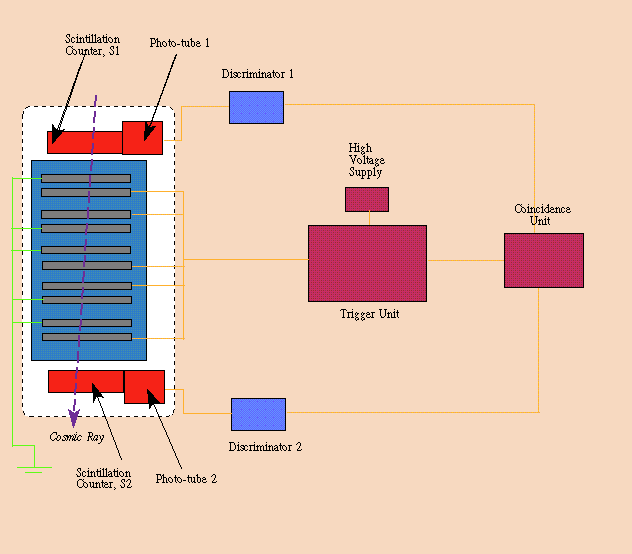
|
|
Our spark chamber consists
of 16 modules, each module being approximately (47cm x
30cm x 0.8cm).
The design is quite robust - a spark chamber in particle physics
research would normally consist of
much less material.
There are two scintillator detectors, each connected to a small
photomultiplier tube, one above the uppermost module
(visible below), and one underneath the lowest module (less visible in
photograph). 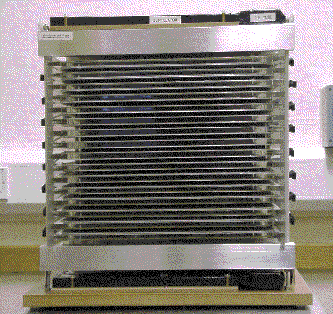 |
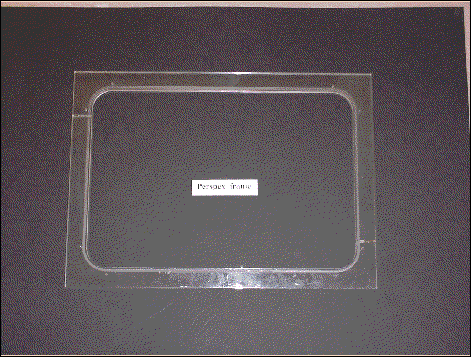
|
Each
module consists of a perspex
frame, 0.8cm thick The detector consists of the 16
modules, mounted
one on top of the other. |
|
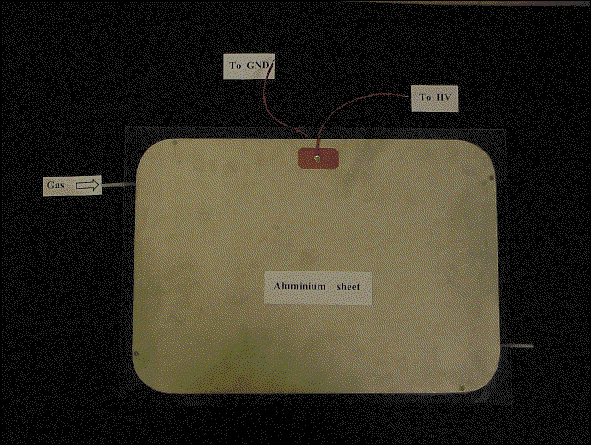
|
On
the top
and bottom of these perspex frames are glued 3mm thick aluminium plates: |
|
For each module, one aluminium
plate is connected to ground
while the other is connected to the High
Voltage (HV) circuit.
The active volume of each module
(within
the perspex frame and between the aluminium plates) is
filled with a noble gas mixture (70% Neon, 30%Helium). The gas flows in
series from one module to
the next, through all 16 modules.
At the top and bottom of the
spark
chamber, covering the active area of the modules, are
plastic scintillation counters. When a charged particle passes through
the scintillation counters ionisation is produced which subsequently
de-excites, emitting visible light. The photons are detected by a
photomultiplier tube. Since both the scintillation counter and
phototube have a fast response time, the
resulting electrical signals indicate in a very short time the passage
of charged particles.
|
Types
of Particle
Here are some
brief details of different types of particle
mentioned throughout this web-site.
Baryons Are particles made up of 3
quarks
(see below)Examples include the
proton (p), neutron (n)
Kaon
(K) Kaons are mesons (see below)
Leptons
There
are three types of
charged lepton: the electron, muon
and tau, each of which has an
associated neutrino (electron neutrino, muon neutrino, tau neutrino) The properties of each
are summarised below. For
each lepton there is a corresponding antiparticle (positron, anti-muon
and anti-tau).
Each of these also has a corresponding anti neutrino.
Mesons Mesons are
particles made up of a quark
and an anti-quark.
Examples of mesons are the Kaon ,
Pion , Psi particles.
Muons Muons are leptons. They
have a
charge of -1 (electron charge). The muon
is 200 times bigger than the electron. Most of the particles
detected by the spark chamber are muons, as they are very penetrating,
and have a long lifetime.
Neutrino
Italian, for "little neutral one," These are very low mass particles which have no charge. There are many, many
billions of neutrino's passing through your little finger's nail every
second, and their main source is thought to be from the Sun. They are
so unreactive, that if they
were to travel through a light year worth of lead, there would only be
50% change that it would hit anything along the way.
Much experimental work is currently being done to understand the mass
and related properties of the neutrinos. The neutrino has a very,
very small mass and may constitute the source of some of the so called
'Dark Matter'
present in the universe.
Pions Also known as pi-meson.
Pions are elementary particles classified as a meson. The pion can be positively , negatively or neutrally charged.
These charged pions decay into muons
and neutrinos, the neutral pions convert directly into photons.
Positrons These are identical
particles to electrons, having the same
characteristics. The only difference being that they are positively
charged. This is an example of antimatter, and releases gamma
radiation when it collides with matter.
Quarks
One of the fundamental constituents
which make up matter. To give an
example:
It is well known that an atom consists of neutrons, protons and electrons. If you
could probe to see inside a proton or a
neutron, you would find that each contained three smaller, constituent
particles called
quarks.
There are six quarks, each with its own flavour which can be simplified to a
type of quark. These are:
up (u), down (d), strange (s), charm (c), bottom (b) and top (t).
Particles with half
integer 'spin' (angular momentum) are called fermions and consist of three quarks.
Particles with integer
spin 'spin' are called bosons and consist of
quark-antiquark pairs.
For example,
the proton is made of a two u quarks
and one d quark, the neutron
consists of two d quarks and one u quark. The positively charged pion
consists of one u
quark and one anti-d quark.
The proton, neutron, and pion
are by no means the only particles
which are made of quarks. All
strongly interacting particles, known as baryons or mesons, are made of
quarks.
What does a spark chamber detect?
There are two types of cosmic rays which exist, primary and secondary. Primary
cosmic rays are the names given to cosmic
rays when they are initially formed (Click
here to find out where cosmic rays come from). However, primary
cosmic rays are very rarely detected at ground level because they
generally undergo collisions with atoms very high up in the atmosphere.
These collisions produce a cascade of secondary cosmic rays which
shower down through the atmosphere to the earth's surface. It is of
this type of cosmic ray which the spark chamber detects.
The diagram below shows the primary
cosmic ray colliding with the nucleus at about 60Km above ground level, where the
collision produces a cascade of
secondary particles, known as a cosmic-ray shower.
A Cosmic Ray Shower
It can be seen that the secondary
cosmic rays include pions (which decay to muons, neutrinos and
gamma rays) as well as positrons and
electrons produced by muon decay and gamma ray interactions with
atmospheric atoms.
Why can
primary cosmic rays decay and produce secondary cosmic rays?
Primary cosmic rays, as
discussed above have high energy,
E. By the usage of Einstein's
well known equation, E = mc2,it can be seen that the
energy of the
primary cosmic ray can be converted into new mass, i.e. new particles can be
produced from the energy of the primary cosmic ray. These new
particles are the secondary cosmic rays. After a while, and if enough energy is available to individual
secondary particles, these can decay to produce yet more secondary
particles.
It can therefore be appreciated that one primary cosmic ray can cause
the
production of many secondary cosmic rays which is what the spark
chamber detects. The nearer one gets to ground level, the secondary
particles become less and less energetic. So the energy of most
secondary cosmic rays detected at ground level is a lot less then the
energy of the original primary cosmic ray.
Although the spark chamber will detect
all secondary cosmic rays, it is mainly muons which it detects. This
is because muons are
very penetrating as they only interact
electromagnetically. They also have a long
life-time (only 2.2ms, but they travel at the speed of light, so
they travel very far) and there
are thus lots of them
around at
ground level which the spark chamber detects.
Cosmic Rays
A spark chamber can be used to detect
cosmic rays. Cosmic rays are
high energy charged particles which typically have energies
ranging between 106
- 1020 eV (around
10-13 - 10-10
Joules). Although in these
terms this does not sound a very large amount of energy, the energy is
very concentrated; the particles are extremely small (typically 10-29kg
and of the order 10-18m in
radius, or
0.000000000000000001 metres in
radius) it can be appreciated that this is a large energy for each of these minute
particles to have.
Cosmic rays originate in outer
space,
(mainly from supernova explosions but also from stars see "where do
cosmic rays come from"
to read more) travel at the
speed of light and strike the Earth from all directions.
The cosmic rays strike the Earth's surface at the rate of about 1 cosmic ray every square centimetre every
minute. Perhaps a more meaningful way to look at this is that
during an average nights sleep a person will have on average of a
million cosmic rays traveling through their body!
Cosmic rays are very penetrating;
so much so that they have also
been detected under the ground,
such as in the London Underground system and down deep mines. The
table below gives some comparison of penetration for different types of
radiation,
so that cosmic rays can be compared.
| Radiation |
Mass |
Electric Charge |
Average Penetration
Depth in Air |
Summary |
| X-rays |
0 |
0 |
100m |
Very energetic form
of light |
| Alpha rays |
3.7GeV |
+2e |
0.1m |
Equivalent structure
to He nucleus |
| Gamma rays |
0 |
0 |
1km |
Very energetic form
of light |
| Primary cosmic
rays |
Mixed |
Mixed |
approx. 10km |
Mostly Hydrogen
and Helium nuclei |
| Secondary cosmic
rays |
Mixed |
Mixed |
approx. 10km |
Mostly muons |
How
are
cosmic rays useful in science?
(A) The large
energies of cosmic rays allow them to be used to smash up atoms
from which more can
be learnt about the atom and the structure of matter.
(B) The source of cosmic rays are of interest
to astronomers and cosmologists (see the University of
Birmingham Astrophysics web page: http://www.sr.bham.ac.uk )
(C) Radiocarbon
dating resulted from cosmic ray research (see
http://www.cq.rm.cnr.it/c-14.html )
Where do
cosmic rays come from?
All the light and the heat which we receive on the Earth comes
from the
sun, so it seems reasonable
to suspect that cosmic rays
may also come from the sun. This however, is not the case. There
are two
pieces of experimental evidence which back up this statement.
Firstly,
it is well known that during the day it is light and at night it is
dark, in other words a variation of
light intensity seen on Earth occurs during a day (24 hour
cycle). Similarly the hottest part of the day occurs between 11am and
3pm, the coolest part occurring in the early hours of the morning. In
other words there is a heat variation during the day. Based on these
facts, it is reasonable to assume that if
cosmic rays came from the sun, they too would have some daily variation
in intensity. For example, the intensity of cosmic rays received
by the Earth would be large around lunchtime, and much less in the
middle of the night. However no such variation is observed. Indeed the
cosmic rays received by the Earth is (nearly) constant at all times
during the day.
The second
reason why cosmic rays cannot come from the sun, is that the
sun is not able to give out particles with the high levels of energy
which cosmic rays are known to have.
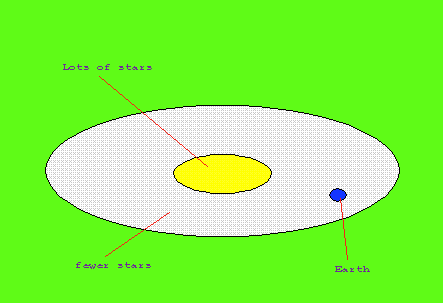 |
Evidence
also exists to suggest that cosmic
rays cannot exist
outside of our galaxy. In order to understand why this is so it
is
first necessary to consider what exactly our galaxy looks like.
The milky way galaxy can be modeled as a 'fried egg' |
The galaxy has a large number
of stars at its centre and fewer
further out. In fact, photos of our galaxy actually support this
idea;
at the center, a "mush" or "mix" of stars, where the large amount of
light coming from them prevents us from seeing them separately. In all,
our galaxy contains about 100,000
million stars. The Earth is found towards the edge of the galaxy. The
galaxy is a spiral shape and is rotating
at 290km/s which is
equivalent to 640,000mph. This means that all the stars and planets
within the galaxy are also rotating. Therefore the Earth is
rotating
and moving through space, relative to neighboring galaxies, with a
speed of 640,000mph. The maximum speed a car can legally travel in
Britain is 70mph, 9143 times slower than the speed with which the Earth
is moving through space. When Usain Bolt
broke the 100m world record,
he ran at a speed of around 0.01km/s. Concorde travelled a
little faster when it was still in service, and was capable of speeds
around 0.63km/s.
The fact that the Earth is moving through space implies
that the intensity of the cosmic rays
coming from outside of space would
be greater on the side of the Earth facing the direction from which the
cosmic rays came.
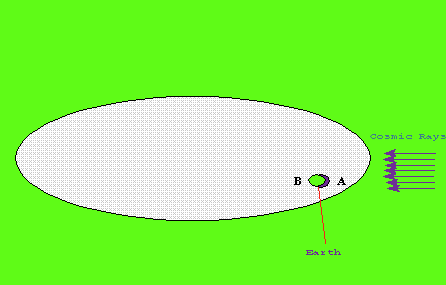 |
To make this clearer, consider the figure on the left.
If cosmic
rays come from outside of the galaxy, say traveling (as shown) from
right to left, then the number of cosmic rays received on face A must
be greater than the number received on face B, (as the purple cosmic
ray intensity shadow shows)
|
Cosmic
rays from outside of our galaxy?
Furthermore, if cosmic rays come
from
outside of the galaxy "cosmic
ray intensity" would change at
different times during the day, due to the fact that the Earth
is spinning on it's own axis. No such
variation is observed. Indeed the cosmic ray intensity on all points on the
Earth's surface are roughly the same, at all times during the day.
Therefore it is thought cosmic rays have no spatial or time variation.
We conclude from these observations that the majority of cosmic rays must originate
within our galaxy. The next question which inevitable follows
is: where from within our galaxy do
cosmic rays come from?
Some cosmic rays are formed
from stars, but most come from Supernova
explosions. As keen
astronomers will know, a star "lives" for around 1 billion years. At
the
end of their lives, some stars explode. These are called
Supernova
explosions. About 100 supernova explosions occur during one year
(within our "horizon" of space), and
they
are observed mostly by professional astronomers, although during
February, 2001, the 5th ever supernova explosion seen by an amateur was
recorded. Since this website was first made, 5 more significant t hey
release atomic nuclei. These atomic nuclei are the source cosmic
rays and are mostly hydrogen and helium nuclei. These source cosmic
rays are known as Primary cosmic rays.
supernovae have been recorded. In our galaxy, a supernova only happens
every 50 years, (on average.) When supernova explosions occur
Are cosmic
rays harmful?
Primary cosmic rays could, potentially
cause damage to cells in the body, and can cause cancer. Some
scientists also have a theory, that cosmic rays may have altered Man's
evolution, by altering DNA. However, it is highly unlikely that the primary rays will
reach ground level (although it is not unknown); they will have
already collided in the upper atmosphere. Secondary rays, which are common
around ground level, are not harmful.
If they were, or if the upper atmosphere didn't stop the primary rays,
life on Earth may not have been possible.
Why
does
the Spark Chamber spark?
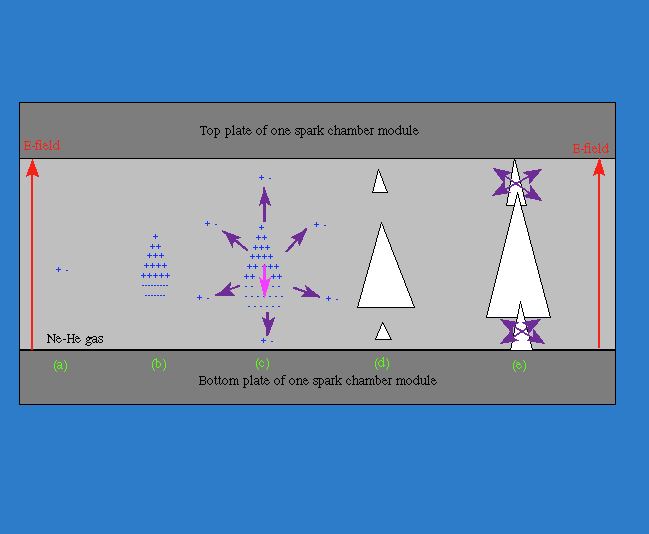 |
The
simple
explanation to this question is given in Stage 3 of
'How the Spark Chamber works'. When a cosmic ray has traveled through
the detector, a large potential
difference exists across
each module. This is a
very unstable situation, of
which the
modules cannot stay like it for any length of time. The plates must discharge.
This discharge will occur along
the easiest path possible. The easiest path is through the ionised track left behind in the Ne-He by
the passage of a cosmic ray. Therefore the plates willdischarge down the ionised track of the
cosmic ray, and hence the characteristic "spark" is observed,
and the 'crack' from the discharge is heard.
|
Stages of spark
formation within one module of the Spark Chamber
(adapted from Rice-Evans, 1974)
A large potential difference
across the closely spaced parallel plates of each module has
associated with it an electric field in the vicinity of the plates. An
electron present in the active
region of each module (created from the ionisation of the gas mixture
as a charged particle traversed the chamber) is accelerated towards the
anode plate.
As the electron traverses the
active region, its energy increases, which becomes great enough to
cause
ionisation when it collides with a gas molecule in its path. An
additional electron is liberated which, after acceleration will also be
able to ionise. This process
continues and results in the formation of an "avalanche", which
rapidly builds up. Electrons
move towards the 'head' of the avalanche,
whilst ions move in the opposite direction.
When the number of electrons in
the head approaches 106,
the avalanche
begins to slow down due to the
attraction of the
positive ions. When 108
electrons in the head is reached, an electric field within the avalanche is
created, which is in the opposite
sense to the electric field between the plates (shown in pink in figure 1c). Recombination of electrons and ions results
within the avalanche, and photons are
emitted isotropically from the "avalanche". The emitted photons
cause ionisation of surrounding molecules in the vicinity of the
original avalanche. The field in front and behind the original
avalanche is enhanced, whilst the field around the sides are
suppressed. Thus ahead and behind of
the original avalanche, new avalanches rapidly form (figure d) until the old and new avalanches merge,
forming a streamer (figure e).
The extremities of the streamer grow
(in approximately 10ns) until they
arrive at the plates. Thus, the
two plates of each module are
connected by a low resistance
conducting plasma of electrons and positive ions, which extends
in a parallel direction to the electric field lines. A spark subsequently passes
between the two plates.
Contact Us
This web-site has been constructed by
Stephen A. Bull as part of a final year undergraduate project and
has been subsequently updated by James Fleming and Jessica Cuttriss as
part of work experience
placements in 2010. The site will be maintained
by the particle physics group.
Whilst every effort has been made to
ensure that all the information given on this site is accurate and
correct, no responsibility can be taken by the author or indeed the
University for any inaccuracies
found on these pages. We would
appreciate any feedback and suggestions for improvements. Also anyone
interested in learning more
about Particle Physics at
Birmingham, the School of Physics and Astronomy, or anyone interested
in
studying for a degree at
the University of Birmingham may contact us. We will be delighted to
hear from you.
Email:
spark.chamber@hep.ph.bham.ac.uk
Or write to us at:
Spark Chamber Correspondence
C/O Dr.
J.A. Wilson
School
of Physics and Astronomy
The
University of Birmingham
Edgbaston
Birmingham
B15 2TT







